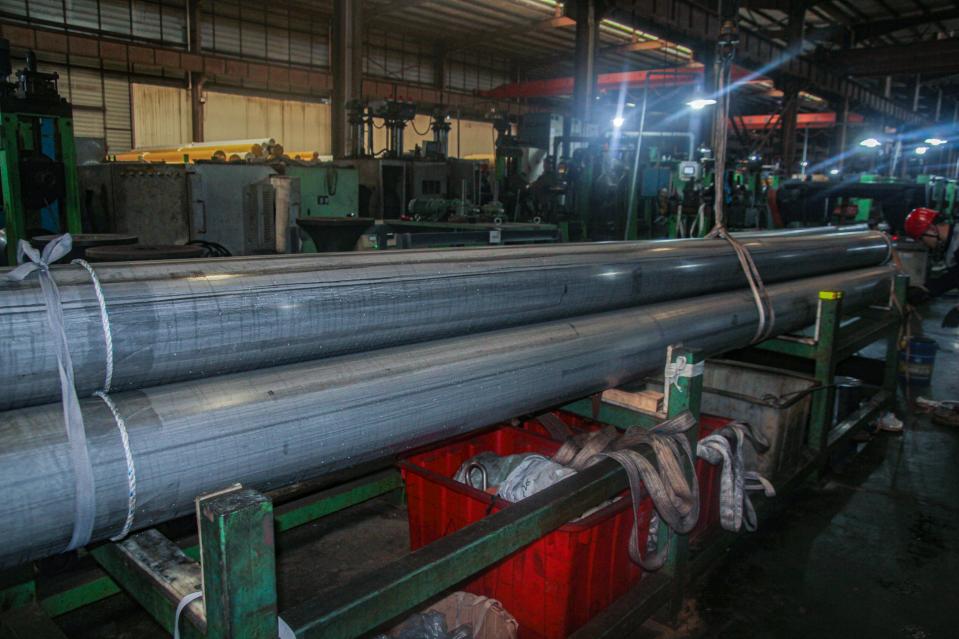Why Is Rapid Cooling Essential for Stainless Steel Seamless Pipes?
In the production of stainless steel seamless pipes, one of the most critical steps after heat treatment is rapid cooling, often referred to as quenching. This process plays a decisive role in determining the final mechanical strength, microstructure stability, and corrosion resistance of the material. At Ganyeah Group, we apply advanced rapid cooling techniques to ensure that every stainless steel pipe meets the highest performance standards for demanding industries such as petrochemical, energy, and marine engineering.

DNV stainless steel pipes for offshore platforms
Purpose of Rapid Cooling
1. Improving Microstructure and Performance
For austenitic stainless steels such as 304 and 316, rapid cooling after solution annealing prevents the precipitation of carbides (Cr₂₃C₆) along grain boundaries. This helps avoid intergranular corrosion and maintains a stable austenitic structure. The process allows carbon and other alloying elements to remain fully dissolved within the austenite phase, which significantly enhances both corrosion resistance and mechanical strength.
2. Stress Relief for Dimensional Stability
During manufacturing—particularly in cold working or welding—residual stress builds up inside the pipe. These internal stresses can lead to deformation, cracking, or stress corrosion during service. Rapid cooling helps release residual stresses, ensuring dimensional accuracy and long-term stability of the stainless steel pipe.
3. Boosting Production Efficiency
Rapid cooling shortens the cooling cycle time, allowing the pipe to reach ambient temperature more quickly. This not only increases production efficiency but also reduces energy consumption and processing costs, aligning with Ganyeah Group’s commitment to sustainable manufacturing practices.
Common Methods of Rapid Cooling
1. Water Quenching
Water quenching is the most widely used method for rapid cooling of stainless steel seamless pipes. The pipe is submerged in water to quickly dissipate heat.
- Advantages: Fast cooling speed and effective carbide suppression.
- Applications: Suitable for stainless steels with high carbon (>0.08%) and chromium (>22%) content, or larger-diameter pipes with a wall thickness over 3 mm.
2. Air Cooling
Air or compressed air cooling is a gentler method where pipes are cooled using forced airflow.
- Advantages: Lower risk of distortion and cracking.
- Applications: Ideal for thin-walled pipes (below 3 mm) or grades with carbon content below 0.08%.
3. Specialized Cooling Techniques
In high-precision or high-performance applications, spray cooling or liquid nitrogen cooling may be used.
- Spray Cooling: Uses a combination of cooling fluid and airflow to ensure uniform temperature reduction.
- Liquid Nitrogen Cooling: Extremely fast and uniform cooling, ideal for special alloys or precision components—but at a higher cost.
Key Considerations During Rapid Cooling
1. Controlling Cooling Speed
Although the process is called “rapid cooling,” it must be carefully controlled. Excessive cooling rates may induce thermal stress, leading to deformation or cracking. Each stainless steel grade requires an optimized cooling profile based on composition, size, and wall thickness.
2. Preventing Surface Defects
During quenching, impurities such as water stains or scale can adhere to the pipe surface, affecting its appearance and subsequent finishing. To avoid this, the cooling medium must be kept clean, and surface drying should be performed immediately after quenching.
3. Ensuring Uniform Cooling
Uneven cooling can cause local overheating or overcooling, resulting in distortion or microstructural imbalance. Techniques like rotation or oscillation during cooling ensure that every section of the pipe is evenly exposed to the coolant.
Why Ganyeah Group Excels in Stainless Steel Heat Treatment
As a trusted manufacturer and exporter of stainless steel seamless pipes, Ganyeah Group integrates precision-controlled heat treatment and rapid cooling systems across all production lines. Our facilities are equipped with automated water-quenching and air-cooling equipment, ensuring consistent quality across diverse grades such as 304, 316L, 321, and duplex stainless steels.
By controlling temperature, cooling speed, and atmosphere, we guarantee stainless steel pipes with:
- Uniform microstructure and stable performance
- Superior resistance to intergranular and stress corrosion
- Excellent mechanical strength and weldability
Applications of Rapidly Cooled Stainless Steel Seamless Pipes
Thanks to their enhanced properties, rapidly cooled stainless steel pipes are widely used in:
- Oil and Gas Pipelines – For resistance to chloride-induced corrosion
- Heat Exchangers and Condensers – Ensuring structural integrity under temperature fluctuations
- Chemical Processing Systems – Where pitting and crevice corrosion resistance is critical
- Power Generation Equipment – Including boilers, turbines, and nuclear reactors
